
Circuit Diagram
Index 609
CLOCK_FOR_TEST_MESSAGES
Published:2009/7/15 1:54:00 Author:Jessie
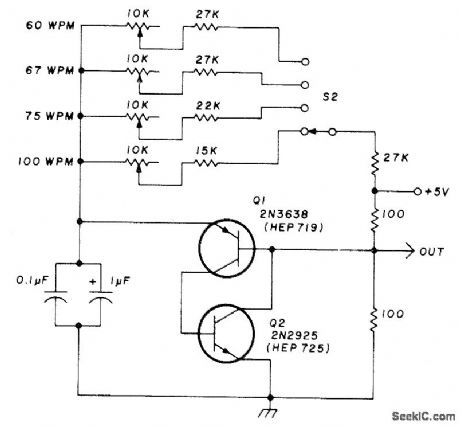
Generates negative going pulse train at choice of four baud rates, to control RTTY test-message generator at four different speeds.-K. Ebneter and J. Romelfanger, RTTY Test-Message Generator, Ham Radio, Nov. 1976, p 30-32. (View)
View full Circuit Diagram | Comments | Reading(565)
LIGHT_OPERATED_TURNOFF_TOUCH_SWITCH
Published:2009/7/14 20:00:00 Author:May

When R5 is illuminated by a flashlight, its resistance lowers, leaving only 10,000Ω as the minimum base resistance. That process gives a positive potential to the base of Q1, therefore turning on the transistor, activating RY2, and turning off the SCR. Or you can press S1 to turn the circuitry off. (View)
View full Circuit Diagram | Comments | Reading(758)
TOUCH_SENSOR
Published:2009/7/14 19:55:00 Author:May
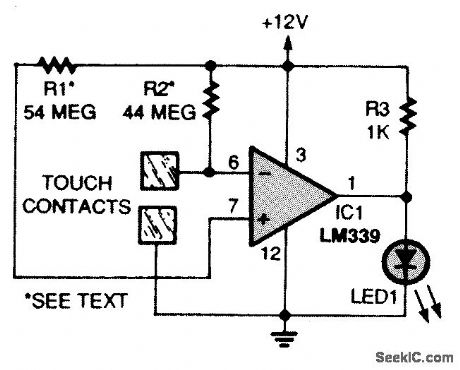
This circuit is a basic two-contact touch-switch sensor circuit. The negative input (pin 6) of IC1 is tied to the positive supply through R2 (which is actually two 22-MΩ resistors connected in series), while the positive input (pin 7) is connected through R1 (made up of two 22-MΩ and one 10-M.Ω resistor in series). (View)
View full Circuit Diagram | Comments | Reading(1904)
RING_COUNTER_FOR_3_PHASE_INVERTER
Published:2009/7/15 1:54:00 Author:Jessie
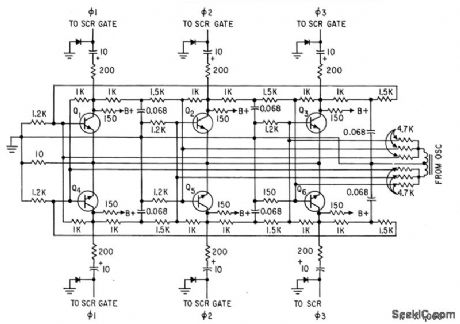
Supplies control signals for all three phases in correct sequence, working from symmetrical Hartley 1,200-cps oscillator,Uses three fip-flops.-M. Lilienslein, Static Inverler Delivers Regulated 3-Phase Power,Electronics,33:28,p55-59. (View)
View full Circuit Diagram | Comments | Reading(929)
100_MHz
Published:2009/7/15 1:54:00 Author:Jessie
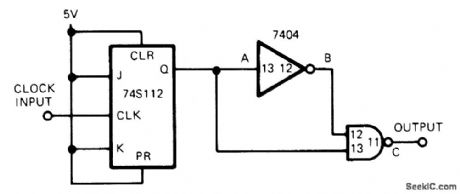
Developed for measuring impulse response of surface acoustic wave devices, for which pulse width had to be under 10 ns for frequency spectrum of about 100 MHz. Propagation delay time of 7404 inverter establishes output pulse width.-R. J. Lang, W. A. Porter, and B. Smilowitz, Simple Circuit Generates Nanosecond Pulses, EDN Magazine, Sept. 5, 1975, p 77-78. (View)
View full Circuit Diagram | Comments | Reading(740)
TEST_CODE_GENERATOR
Published:2009/7/15 1:53:00 Author:Jessie
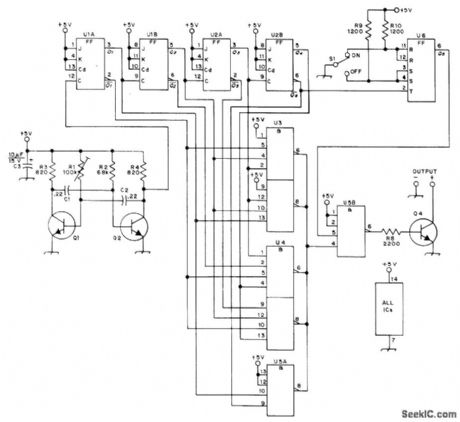
RTTY characters for R and Y are generated alternately in long series for checking system performance. (These letters give widest bandwidth of all character combinations.) Clock pulse at 45.5 Hz is generated by 2SC943 astable MVBR Q1-Q2. 74107 flip-flops U1A-U2B are connected as binary dividers for modulo-8 counter, so any bit between 0 and 7 is available for use with Signetics 8416A gates U3-U5 to feed desired character to 2SC372 output transistor. Automatic start/stop circuit using Fairchild 9945 docked flip-flop U6 ensures that sequence always starts with R and ends with Y. a4 conducts on mark and is cut off on space, for feeding frequency-shift keyer.-K. Sekine, A Simple RY Code Generator for TTY, QST, Dee. 1974, p 20-24. (View)
View full Circuit Diagram | Comments | Reading(974)
QUADRATURE_OUTPUTS
Published:2009/7/15 1:52:00 Author:Jessie

Exar XR-567 tone decoder is connected as precision oscillator providing separate square-wave outputs that are very nearly in quadrature phase. Typical phase shift between outputs is 80°. Supply voltage range is 5-9 V.- Phase-Locked Loop Data Book, Exar Integrated Systems, Sunnyvale, CA, 1978, p 41-48. (View)
View full Circuit Diagram | Comments | Reading(2191)
TOUCH_SWITCH_I
Published:2009/7/14 19:50:00 Author:May

This touch switch controls an ac-powered bulb, and requires only a few parts. Touching the touch plate triggers the SCR's gate, turning it on and allowing current to flow from the cathode to the anode of SCR1, thereby activating the relay. (View)
View full Circuit Diagram | Comments | Reading(0)
BAUDOT_TO_ASCII
Published:2009/7/15 1:51:00 Author:Jessie
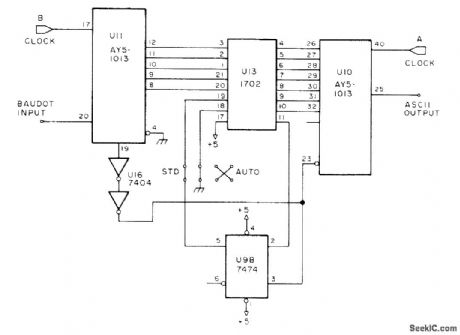
Used with Baudot RTTY codes on amateur bands, to drive Teletype ma chine requiring ASCII code. Separate 555 timers are used as clocks running at 727 Hz and at 1760 Hz. Provides only one-way conversion for receiving capability, but article gives companion circuit for two-way code conversion as required for transmission with ASCII Teletype. On U13, pins 12, 13, 15, 22, and 23 all go to +5 V along with pin 17; only pin 14 is grounded.-J. G. Mills, Baudot to ASCII Converter, 73 Magazine, Sept. 1977, p 80-85.
(View)
View full Circuit Diagram | Comments | Reading(1436)
554_ASTABLE
Published:2009/7/15 1:50:00 Author:Jessie
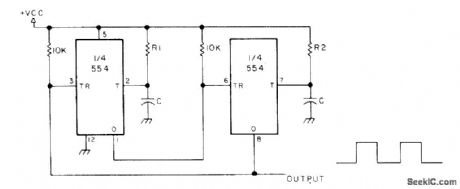
Two sections of 554 quad monostable timer are used. Output frequency is 1/ (R1 + R2) C hertz, and output duty cycle is 100R2/ (R1 + R2). When R1 is equal to R2, symmetrical square wave is obtained VCC is 4.5-16 V at 3-10mA.-H. M. Berlin, IC Timer Review, 73 Magazine,Jan. 1978, p 40-45.
(View)
View full Circuit Diagram | Comments | Reading(669)
KEYER_FOR_AFSK
Published:2009/7/15 1:48:00 Author:Jessie
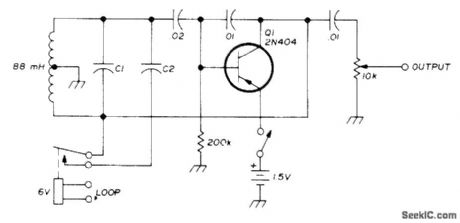
Uses one center-tapped 88-mH toroid tuned to desired RTTY space frequency by suitable value of C1 (0.0628μF for 2295 Hz). When relay is closed, suitable value for C2 (0.0156μF for 2125 Hz) is paralleled with C1 to give desired space frequency. Output is perfect sine wave. Plug output into audio input jack of transmitter. Plug relay coil directly into 150-V 60-mA loop of teleprinter. When loop current is turned on, relay closes and AFSK is on mark. Space frequency occurs when relay is opened by teleprinter keyboard.-J. B. Dillon, Audio-Frequency Shift Keyer, Ham Radio, Sept. 1976, p 45. (View)
View full Circuit Diagram | Comments | Reading(774)
4SUP1_SUP_SUB2_SUB_DIGIT_VOLTOHMMETER
Published:2009/7/15 1:47:00 Author:Jessie
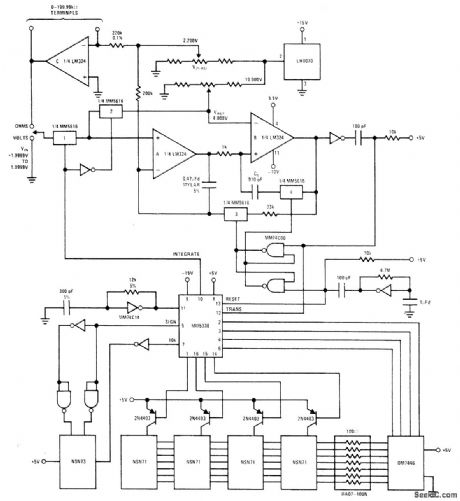
National type MM5330 IC provides logic circuits for implementing low-cost 41/2-digit voltohmmeter. Display interface consists of TTL 7-segment decoder driver and four 2N4403 transistors. Operation is based on counting of up to 80,000 clock pulses. Circuit provides sign digit, either plus or minus, and numeral 1 for 10,000 to give full display of ±19,999 with decimal point.- MOS/LSI Databook, National Semiconductor, Santa Clara, CA, 1977, p 5-23-5-29. (View)
View full Circuit Diagram | Comments | Reading(1514)
TREBLE_BOOSTER_CIRCUIT
Published:2009/7/14 19:48:00 Author:May
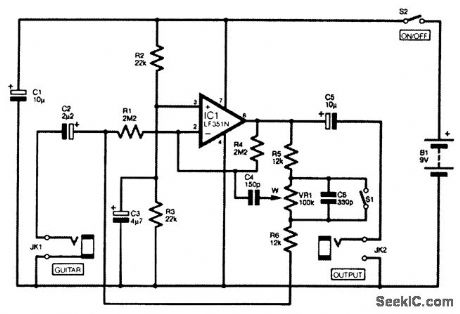
The circuit is basically a noninverting-mode amplifier. Resistors R2 and R3 bias IC1's noninverting input (pin 3), and R1 plus R4 act as a negative feedback network that sets the closed-loop volt-age gain of IC1 at unity. However, R1 and R4 are used only to set the operating conditions of IC1 at dc and at low to middle audio frequencies. The high-frequency voltage gain is governed by a more-complex negative feedback network that is composed of resistors R5 and R6, potentiometer VR1, and capacitors C4 and C6. R5, VR1, and R6 form a conventional negative feedback network that enables the voltage gain of the circuit to be varied. With the wiper (w) of VR1 toward the top end of its track, the circuit provides losses of nearly 20 dB. Moving the wiper down to the bottom gives almost 20 dB of gain. It is coupled to the inverting input via capacitor C4, which has quite a low value. Consequently, C4 provides an efficient coupling only at high frequencies. At middle and bass frequencies, capacitor C4 has a very high impedance and provides only a loose coupling to IC1's inverting input.Therefore, control VR1 is ineffective at these lower frequencies, where the voltage gain of the circuit is largely governed by resistors R1 and R4. This permits the required boost and cut to be obtained at high frequencies, but keeps the gain at about unity at middle and low (View)
View full Circuit Diagram | Comments | Reading(1259)
FSK_DECODER_1
Published:2009/7/15 1:46:00 Author:Jessie

R0 and C0 set PLL center frequency for Exar XR-2211 FSK demodulator/tone decoder. R1 sets system bandwidth. C1 sets loop filter time constant and loop damping factor. CF and RF form postdetection filter for FSK data output. Table gives values for most commonly used FSK bands.- Phase-Locked Loop Data Book, Exar Integrated Systems, Sunnyvale, CA, 1978, p 29-34. (View)
View full Circuit Diagram | Comments | Reading(3297)
GUITAR_TREBLE_BOOSTER
Published:2009/7/14 19:45:00 Author:May

The circuit diagram shown was designed to increase the treble content of an electric guitar's output. It boosts frequencies above 1 kHz and helps to restore any higher-frequency losses. IC1 is a TL071 op amp connected as a noninverting amplifier, which is connected in the line between the guitar and the main amplifier. Potentiometer VR1 determines the level of treble boost applied; with the values of components shown, it will give between 3 and 20 dB. Resistor R6 and the potentiometer VR1 could be replaced by a fixed resistor, if required. The actual boost frequency is set by the values of resistor R4 and capacitor C2. With switch S1 open, the circuit acts as a voltage follower, with no effect on the guitar signal. Closing S1 grounds C2 to the 0-V line, which introduces the boost. Resistor R5 holds the earthy end of C2 at 0 V when switch S1 is open, and prevents switching noise appearing on the signal when S1 is operated. Resistors R2 and R3 set the input impedance of the circuit at 50 kΩ, which should suit most electric guitars. If the circuit is housed in a diecast case, S1 can be a foot-operated switch and SK1 could be a stereo jack socket with the sleeve and ring connections connected to the battery negative and 0-V rail, respectively. Thus, the unit will switch on automatically whenever the guitar is plugged in. Connect the case for the earth side of the circuit. Expect reasonable life from a PP3 battery. (View)
View full Circuit Diagram | Comments | Reading(2649)
SCR_STATIC_ALTERNATOR
Published:2009/7/15 1:45:00 Author:Jessie

Silicon-controlled rectifiers serve as current-switching elements in ring-counter inverter that delivers three. phase ac output requiring no filtering, with .out moving parts. With 2.4-kc pulse genera tor, output is 400-cps three-phase.-R. H .Murphy, Developing True Solid-State Static Alternators, Electronics, 36:21, p 58-61. (View)
View full Circuit Diagram | Comments | Reading(1476)
ZENER_PROTECTS_METER
Published:2009/7/15 1:45:00 Author:Jessie

Simple overvoltage protection circuit makes 10-V zener conduct when voltage E1 being measured goes over 20-V full-scale limit of voltmeter using milliammeter movement with multiplier resistor R2. This turns on Q1, drawing current through LED to give visual indication of overvoltage, while providing protective shunt path around meter.-H. Olson, Sensitive Meters Saved, 73 Magazine, Oct. 1977, p 153. (View)
View full Circuit Diagram | Comments | Reading(875)
SIMPLE_VERY_LONG_PERIOD_TIMER
Published:2009/7/14 19:43:00 Author:May
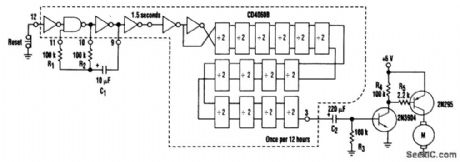
This circuit is straightforward. An RC oscillator consisting of R1, R2, and C1, with the internal gates on the CD4060, generates a 1.5-second clock that is subsequently divided to a 12-h clock at the output. Other times are available for output or for AND-ing with the longer-duration signals. The output is capacitively coupled to the two-transistor driver to provide a several-second pulse every 12 hours. (View)
View full Circuit Diagram | Comments | Reading(1613)
FSK_WITH_SLOPEAND_VOLTAGE_DETECTION
Published:2009/7/15 1:43:00 Author:Jessie

Motorola MC1545G gated video amplifier is used with slope and differential voltage comparators to provide switching of output alternately between input signal fl at 2975 Hz and f2 at 2125 Hz. With gate level on pin 1 of MC1545G high (greater than 1.5 V), signal applied between pins 4 and 5 is passed and signal between pins 2 and 3 is suppressed. With gate low (less than 0.5 V), situation is reversed. To avoid generation of spurious frequencies and noise, gate control voltage is allowed to change only when rate of change of fl and f2 have same sign and values of fl and f2 themselves have same sign and equal magnitude within several millivolts. Data rate is about 170 Hz.- Gated Video Amplifier Applications-the MC1545, Motorola, Phoenix, AZ, 1976, AN-491, p 12. (View)
View full Circuit Diagram | Comments | Reading(622)
PROGRAMMABLE_TIMER_SEQUENCER
Published:2009/7/14 19:40:00 Author:May

The circuit diagram of this programmable sequencer could be applied in a number of timing uses. Prior to the start of each interval, an audible tone is generated, and a seven-segment LED display shows the interval number. Prior to the end of that inerval, the buzzer sounds again. IC1 is a 2240 timer/counter device that clocks up to 256 periods, the durations of which are determined by resistor R1 and capacitor C1. The 2240 has its RESET and TRIGGER pins (10 and 11) wired via a push switch S1.The timer is used to operate a memory chip, IC2. The first 8 addressed bits are used by the timer/counter to step through the 256 steps available for each program. The other 6 bits are selected by an external switch network S2 to S7 which permits up to 26 programs, each of 256 steps. The 27C64 has eight outputs, which was enough for a single-digit LED display plus a piezo buzzer. (View)
View full Circuit Diagram | Comments | Reading(2966)
| Pages:609/2234 At 20601602603604605606607608609610611612613614615616617618619620Under 20 |
Circuit Categories
power supply circuit
Amplifier Circuit
Basic Circuit
LED and Light Circuit
Sensor Circuit
Signal Processing
Electrical Equipment Circuit
Control Circuit
Remote Control Circuit
A/D-D/A Converter Circuit
Audio Circuit
Measuring and Test Circuit
Communication Circuit
Computer-Related Circuit
555 Circuit
Automotive Circuit
Repairing Circuit